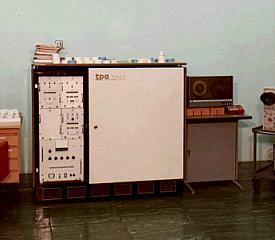
Click on the picture to see the photo of another TPA1001
system!
The very first "stored program data processor" has a long history. The idea of building a programmable device for the tasks of physical analysis dates back to the mid-sixties. There wasn't a computer industry in Hungary around those times, but a few companies tried to start something. For political reasons Hungary was condemned to buy computers from the Soviet Union, other socialist countries, and sometimes from the "western world" (from companies with somewhat "softer" politics than IBM's: ICT, ICL, Univac). Own developments were suppressed by the goverment, so the KFKI MSZKI (Research Institute for Measurement and Computing Techniques) decided to build "stored program analysers" instead of computers. (Some hungarian companies didn't like the fact that a scientific institute manufactures computers for the market, and tried to did everything to stop them until the late eighties!) The main goal was to provide a versatile computing device for the physical research insitutes, scientists (the idea of building computers for the general market came years later).
The first computer in the Central Insitute for Physics was a soviet Ural I (1960), a big tube-machine, but the ICT 1905 that arrived around '66 proved to be more important: the technical people at the MSZKI finally had an oportunity to examine a working design, and learn. Around the same time new japanise transistors became available, and one day someone brought a Digital Small Computer Handbook, with the instruction set listing of the PDP-8 "minicomputer" in it. They knew, that one of the main usage field of the PDP-8 was scientific analysing, so they decided to build a machine like that. They re-implemented the PDP-8 instruction set with minor differences (like shift left and right wasn't available directly, this was considered as a serious bug).
The designers had to build a set of standardised cards with discrete components (transistors, diodes, resistors, etc) on them, the TPA1001 consisted of these cards. You can see the opened card cage and the cooling fans on this picture.
The basic configuration had 4K of core memory (expandable to 32K), a Teletype ASR33 as console input, a nice panel with lights and switches for the main registers (a normal office desk with this device on top!) and a papertape punch/reader. Later other peripherals and storage became available too.
The prototype was presented at the first congress of the John von Neumann Computing Society (von Neumann, the father of the stored program computing device and originator of many important ideas was hungarian; this society played an important role in the history of hungarian computing)in 1968, the displayed machine played the tune "Massachusetts" (a small tribute to Maynard). The first users were scientists of the KFKI, the feedback was great: they finally had a device like their "western" collegues. The PDP-8 computer was welcomed in Hungary, so the "Digital path" stayed until the end of the TPA-years.